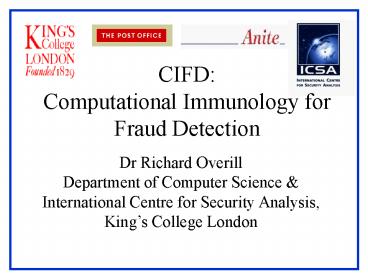CIFD: Computational Immunology for Fraud Detection
1 / 13
Title:
CIFD: Computational Immunology for Fraud Detection
Description:
CIFD: Computational Immunology for Fraud Detection. Dr Richard Overill ... Computational Immunology (aka Artificial Immune Systems, AIS, in the USA) has ... –
Number of Views:65
Avg rating:3.0/5.0
Title: CIFD: Computational Immunology for Fraud Detection
1
CIFDComputational Immunology for Fraud Detection
Dr Richard Overill Department of Computer Science
International Centre for Security
Analysis, Kings College London
2
Computational Immunology for Fraud Detection
- DTI LINK project funded under Phase 1 of the
Management of Information programme - Application of adaptive, self-learning
technologies with low overheads (CI) to fraud
detection in the financial sector - Partners (with Kings College London)
- Anite Government Systems Ltd. (developer)
- The Post Office (end user)
3
Natural Immune Systems
- are multi-layered (defence in depth)
- consist of several sub-systems
- innate immune system (scavenger cells which
ingest debris and pathogens - acquired immune system (white blood cells which
co-operate to detect and eliminate pathogens /
antigens)
4
Acquired Immune System
- Detector cells generated in bone marrow
(B-cells), and in lymph system but matured in
thymus gland (T-cells). - Self-binding T-cell detectors destroyed by
censoring (negative selection) in thymus. - B- remaining T-detectors released to bind to
and destroy foreign (non-self) antigens.
5
(No Transcript)
6
Digital Immune Systems I
- Train with known normal behaviour (self)
- Generate database(s) of self-signatures.
- Generate a (random) initial population of
detectors and screen it against database(s). - Challenge the detectors with possibly anomalous
behaviour (may contain some foreign activity).
7
Digital Immune Systems II
- An (approximate) match between a detector and an
activity trace indicates a possible anomaly. - React to (warn of) the possible anomaly.
- Evolve the population of detectors to reflect
successful and consistently unsuccessful
detectors (cloning / killing).
8
Digital Immune Systems III
- Can be host-based or network-based
- Host-based systems monitor behaviour or processes
on servers or other network hosts. - Network-based systems are of 2 types
- statistical traffic analysis using e.g. IP source
destination addresses and IP port / service. - Promiscuous mode sniffing of IP packets for
anomalous behaviour.
9
Application to CIFD
- Build a database(s) of normal transactions and
sequences of transactions. - Look for anomalous and hence potentially
fraudulent patterns of behaviour in actual
transactions and transaction sequences, using the
detector matching criteria. - Adapt the detector population.
10
Advantages of CI
- Redundancy collective behaviour of many
detectors should lead to emergent properties of
robustness and fault tolerance - no centralised
or hierarchical control, no SPoF. - Memory of previous encounters can be built in,
e.g. as long-lived successful detectors. - Various adaptive learning strategies can be tried
out, e.g. affinity maturation, niching.
11
Disadvantages of CI
- Subject to compromise in similar ways to the
human immune system, i.e. - subversion via auto-immune reaction (cf.
rheumatoid arthritis) where the system is induced
to misidentify self as foreign. - subversion via immune deficiency response (cf.
HIV-AIDS) where the systems response is
suppressed - misidentifying foreign as self. - subversion by concealing foreign behaviour in
self disguise (Wolf in sheeps clothing or
T.H.)
12
Previous Applicationsof CI
- Computational Immunology (aka Artificial Immune
Systems, AIS, in the USA) has already been used
successfully for - detecting the activity of computer viruses and
other malicious software (IBM TJW Res Cen.) - detecting attempted intrusions into computers and
networks (New Mexico Memphis Univs)
13
Thank you!Any Questions?ContactTel 020
7848 2833Fax 020 7848 2913Email
richard_at_dcs.kcl.ac.uk































